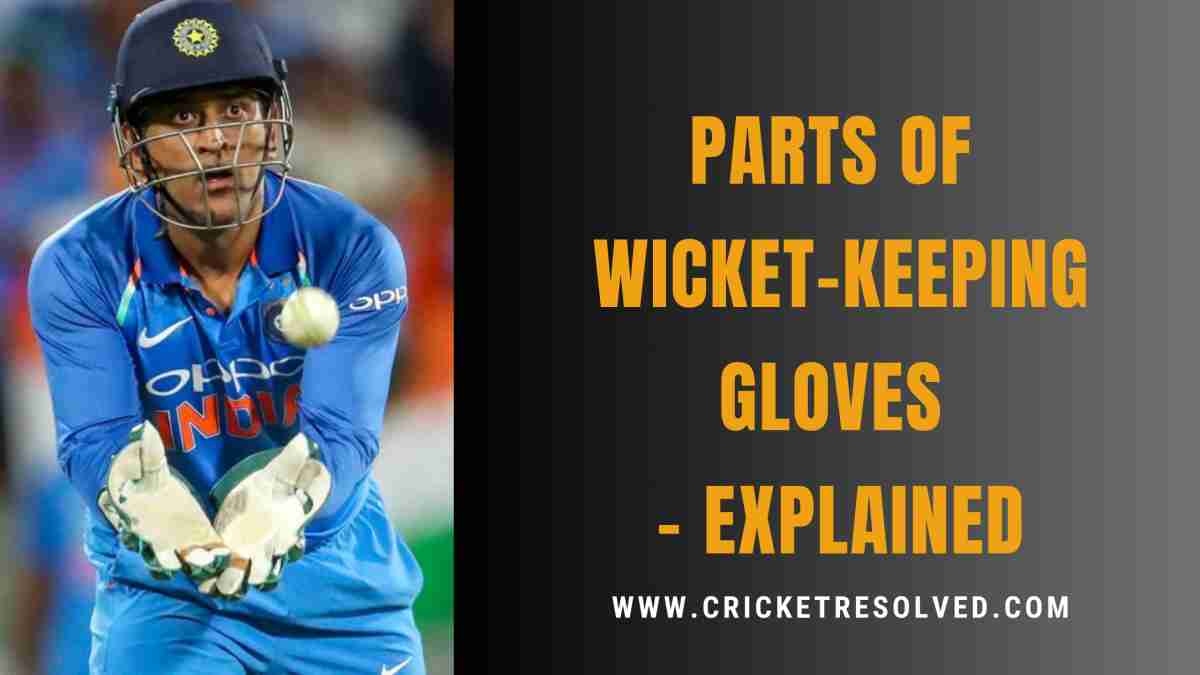
Wicket-keeping gloves are a must-have item for anyone who keeps wickets in cricket. They protect the wicketkeeper’s hand and wrist from the force of the ball and also help him or her hold on to the ball well.
This piece will talk about how wicket-keeping gloves are put together and what each part does.
Wicket-Keeping Gloves
The catching surface of wicket-keeping gloves is frequently made of rubber and has traction-enhancing features such as spikes. Soft cushioning material is attached beneath the catching surface to reduce the impact of the ball.
A protective padded cuff covering the wrist region is also included on the anterior surface, albeit it is generally leather-encased and does not provide a catching surface.
Parts of Wicket-Keeping Gloves
Palm Lining
The palm lining is the section of the wicket-keeping glove that comes into touch with the palm of the hand. The palm lining is made of both leather and cotton.
The lining of the wicket-keeping glove must be soft and pleasant because it sits right beneath the area that will be used most frequently to catch the cricket ball. This will help to prevent friction and chaffing.
Palm Padding
The palm padding in wicket-keeping gloves is critical for providing the best possible impact protection by decreasing the force that flows through the gloves and onto your hands, saving you from harm.
The padding is important for executing a good catch since the shock-absorbing characteristics aid in slowing down the ball and reduce the likelihood of the cricket ball bouncing out of your hands. They are cushioned with leather and synthetic materials.
Finger End Caps
Finger end caps cover the ends of the fingers, which are the most common sites for wicketkeepers to receive injuries. These caps, made of PVC or a rubbery material, will bear the brunt of any glancing hits.
End caps are cylindrical pieces with one end open that are affixed to the ends of all five glove fingers and are designed to fit over the tips of your fingers.
Webbing
The material that connects the index finger and thumb on a wicketkeeper’s glove is known as “webbing” because it improves the surface area for collecting the ball.
Also Read | Parts of Cricket Batting Gloves – Explained
Inner Gloves for Cricket
In cricket, both the wicketkeeper and the batter wear inner gloves. Wicketkeepers are required to wear inner gloves, despite the fact that many cricket batsmen do not.
A pair of inner gloves, which provide better shock absorption and a tighter fit between your hands and your wicket-keeping gloves, will be your first line of defence between your hands and your wicket-keeping gloves.
Inner glove palms are comprised of a variety of materials.
Cotton
Simple cotton gloves, known as “cotton inner gloves,” improve fit and moisture management.
Cotton Padded
Cotton-padded inner gloves are simple cotton gloves with additional padding on the fingers and palm for a better fit, improved moisture control, and increased shock absorption.
Types of Wicket-Keeping Gloves
Leather Gloves
These are the most classic wicket-keeping gloves. They protect and grip the best, but they can also be the most expensive.
Hybrid Gloves
These gloves are hybrids because they are made of both leather and plastic materials. They have the security of leather and the low cost of synthetic materials, which is the best of both worlds.
Gloves without Fingers
These gloves don’t cover the fingers, so they can get hit by the ball. They are lighter and more flexible than regular gloves, but they don’t protect your hands as well.
Women’s Gloves
Women’s gloves are made just for women, so they are usually smaller and lighter than men’s gloves. They may also fit and look differently because women tend to have smaller hands.
Also Read | Cricket Pads Decoded: What Are They Made of?
Wicket-Keeping Gloves: Buying Aspects
What kind of wicket-keeping glove is best for you depends on your wants and preferences. Leather gloves are the best choice if you are a serious wicketkeeper who wants the best safety and grip.
If you want something affordable, lighter, and more flexible, fake leather or hybrid gloves might be a better choice. And if you’re a woman, women’s gloves are made to fit your smaller hands and give you the right amount of protection.
Here are a few more things to think about when buying wicket-keeping gloves:
You might not require the most expensive or secure gloves if you’re just getting started. However, you’ll need gloves that can withstand the force of the ball and provide you with the best grip if you wish to play at a higher level.
The Weather: If it is cold where you are playing, you will need padded gloves to keep your hands warm. If it’s hot outside and you want to play, you’ll need gloves made of a material that lets air through to keep your hands cool.
Your Individual Choices: Some wicketkeepers like gloves with a lot of padding, while others like lighter, more flexible ones. In the end, the best way to choose wicket-keeping gloves is to try on a few different pairs and see which ones feel the most comfortable to you.
Final Thoughts
Cricket gloves are one of the most important pieces of safety gear that every cricket player needs. The players need to know what kinds of cricket gloves are out there, which ones fit them best, and which ones they should use to do better on the field.
Every wicketkeeper needs to know the parts of their hands and how they work. The wicketkeeper’s hand and wrist are protected from the contact of the ball by the palm, fingers, webbing, cuff, and inner glove. These parts also help the wicketkeeper get a good grip on the ball.
Depending on the maker and the level of play, wicket-keeping gloves will have different parts, but all of them should offer enough protection and grip. When picking wicket-keeping gloves, you should think about the level of play, the weather, and your own preferences.








